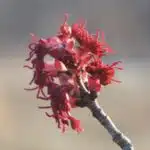Silver maple (Acer saccharinum) is a deciduous tree that is popular for its fast growth rate and stunning foliage. It is native to North America and is widely cultivated as an ornamental tree in parks, gardens, and along streets. Silver maples are known for their striking silver bark, which peels off in thin strips, revealing the smooth green bark underneath. The leaves of silver maples have a distinctive shape with five lobes and serrated edges, and they turn bright yellow in the fall.
Growing and caring for silver maples requires some knowledge about their preferred growing conditions and maintenance requirements. These trees thrive in well-drained soils that are slightly acidic to neutral pH levels. They also require full sun to partial shade exposure to grow healthy and strong. Pruning is necessary to maintain the shape of the tree and remove any dead or diseased branches. In this article, we will provide you with some essential tips on how to grow and care for silver maple trees so that you can enjoy their beauty in your landscape for years to come.
Characteristics Of Silver Maple Trees
Silver maple trees, scientifically known as Acer saccharinum, are native to the eastern regions of North America. They are deciduous trees that can reach up to 100 feet in height and have a spread of 50-70 feet. These trees have an oval-shaped crown with a canopy that is dense and wide. Silver maples are fast-growing and can grow up to 3-7 feet per year.
The leaves of silver maple trees are unique as they have five lobes with deep indentations between them. The leaf is green on top and silver on the bottom, which gives it its name. The leaves are typically 2-6 inches long with a width of 2-5 inches. During the fall season, these leaves turn yellow or reddish-brown before falling off.
One crucial growth pattern of silver maples is their ability to adapt to various soil and environmental conditions, making them ideal for urban settings. However, they tend to grow best in moist soil conditions, close to riverbanks or wetlands. They also require full sun exposure for optimal growth and development. Understanding these characteristics is essential for any gardener or landscaper looking to cultivate healthy silver maple trees in their garden or landscape design project.
As we move forward in understanding how to grow and care for silver maple trees, it is essential first to understand the soil requirements necessary for optimal growth patterns.
Soil Requirements For Growing Silver Maple Trees
As if the characteristics of silver maple trees are not impressive enough, they also happen to be hardy and easy to care for. Proper soil requirements are essential for their growth, and it is important to take note of a few things before planting one in your yard.
Silver maple trees thrive in moist soil that is well-drained, with a pH range between 6.0 and 7.5. It is crucial to maintain this balance because too much acidity can lead to stunted growth or even death of the tree. Regularly testing the pH level of your soil will help ensure that you keep it within the required range for optimal growth.
Mulching benefits cannot be overstated when it comes to growing silver maple trees. Mulch helps retain moisture in the soil, which is critical for this species as they prefer moist environments. Additionally, mulch acts as a natural weed barrier that prevents weed competition for nutrients from harming the tree’s growth. Applying mulch around the base of your silver maple tree will not only benefit its growth but also add aesthetic appeal to your landscape.
Moving onto sunlight and shade requirements, silver maples are known for their ability to grow in both full sun and partial shade conditions. However, they tend to grow faster in full sun environments with at least six hours of direct sunlight daily. When planted in areas with more shade than sun, expect slower growth rates and smaller canopy sizes compared to those grown under full sun conditions. Remembering these requirements is crucial when deciding on where to plant your silver maple tree.
Sunlight And Shade Requirements
Sunlight and Shade Requirements:
The silver maple tree thrives in full sunlight to partial shade. In ideal growing conditions, this tree requires a minimum of 4-6 hours of direct sunlight daily. However, it can tolerate partial shade, especially during the hottest part of the day. When grown in full sun, the silver maple grows faster and develops a denser canopy than when grown in shaded areas.
The ideal location for planting a silver maple is in well-drained soil that is rich in organic matter. The tree prefers moist soil but can tolerate short periods of drought once established. Avoid planting in low-lying areas or near structures because these trees have shallow roots that may cause damage to buildings or sidewalks as they grow.
• Plant the silver maple in an open space where it can receive ample sunlight throughout the day • Choose a location with well-drained soil that is rich in organic matter • Avoid planting near structures or low-lying areas
Moving on to watering needs, providing adequate water is essential for the survival and growth of your silver maple tree. While it prefers moist soil, overwatering can lead to root rot and other diseases. In the next section, we will discuss how much water your tree needs and how often you should water it to ensure healthy growth.
Watering Needs
Watering is an essential aspect of silver maple care. It is important to maintain the right soil moisture level to ensure healthy growth and development. Although these trees are hardy, they require consistent watering in their formative years to establish a strong root system. As a general rule, water your tree once a week during the growing season, ensuring that the soil is moist but not waterlogged.
To determine if your silver maple needs watering, check the soil around its roots. Insert your finger into the soil up to two inches deep. If the soil feels dry at this depth, it’s time to water your tree. When watering, avoid applying too much water at once as this can lead to root rot and other issues. Instead, apply enough water slowly and evenly over an extended period.
To maintain healthy growth, it is crucial to monitor the frequency of watering as well as soil moisture levels. A regular watering schedule can help prevent drought stress and other related problems by maintaining constant moisture levels in the soil. With proper attention paid to watering needs, your silver maple can thrive for many years.
Moving on from watering requirements for silver maple trees, it’s worth noting that fertilizing tips are equally important when aiming for healthy growth and development. By following specific guidelines when choosing fertilizers and applying them correctly, you can ensure that your tree receives all the nutrients necessary for optimal growth without damaging its delicate root system or causing any other issues down the line.
Fertilizing Tips
After ensuring that your silver maple tree is getting enough water, it is important to also consider its nutritional needs. Fertilizing your tree can help it grow strong and healthy, and there are two main types of fertilizers to choose from: organic and chemical. Organic fertilizers are made from natural ingredients, such as compost or manure, while chemical fertilizers contain synthetic nutrients.
When deciding which type of fertilizer to use on your silver maple tree, it is important to consider the potential benefits and drawbacks of each option. Organic fertilizers may have a slower release time, but they provide long-term nourishment for your tree without harmful chemicals. Chemical fertilizers may provide quicker results, but they can also harm beneficial microorganisms in the soil.
The best time to fertilize your silver maple tree depends on the type of fertilizer you choose. Organic fertilizers should be applied in early spring or late fall, while chemical fertilizers should be applied in early spring before new growth begins. By providing proper nutrition for your tree through timely and appropriate fertilization techniques, you can help ensure its continued health and beauty for years to come.
As an arborist or horticulturist caring for a silver maple tree, it is essential to understand the importance of proper nourishment through timely application of the right kind of fertilizer. Whether you opt for organic or chemical options, make sure that you apply them at the right time so that they can benefit your tree most effectively. This will not only help keep your silver maple healthy but also enhance its aesthetic value by promoting lush foliage growth. In the next section, we will discuss pruning techniques that will further contribute to maintaining a beautiful and healthy silver maple tree.
Pruning Techniques
- Pruning young silver maple trees is an important part of their maintenance and should be done with care.
- Removing dead or diseased branches should be done as soon as they are identified to avoid spreading the infection.
- Crown reduction is a pruning technique used to reduce the height and/or spread of a tree, and can be done on silver maples.
- Pruning cuts should be made at a slight angle and just outside the branch collar to prevent damage to the tree.
- The removal of large branches must be done in stages to avoid tearing the bark or tearing of the branch.
- Pruning should be done in the dormant season when the tree is not actively growing.
Pruning Young Trees
Training branches is an essential aspect of growing silver maple trees. It is important to prune young trees during the early stages of growth to encourage a desirable shape and structure. This process involves selecting a central leader and removing any competing or crossing branches that may impede the tree’s future growth.
Winter pruning is the most suitable time for pruning young silver maples. During this dormant season, it is easier to identify which branches need to be removed while minimizing damage to the tree. Additionally, winter pruning reduces the risk of spreading diseases and pests as they are less active during colder temperatures.
When pruning young silver maples, it is important to keep in mind that excessive pruning can lead to stunted growth and weaken the tree’s overall health. Therefore, it is recommended to only remove up to one-third of the total canopy at a time. Regular training and maintenance will ensure healthy growth for your silver maple tree for years to come.
Deadheading
Pruning techniques are essential in maintaining the health and beauty of trees. Deadheading is one of these techniques that arborists and horticulturists use to promote plant growth while enhancing the aesthetic value of a garden or landscape. Deadheading is the process of removing spent or faded flowers from plants, which stimulates new growth and prolongs blooming.
Deadheading is typically done using gardening tools such as pruning shears or scissors. This technique is beneficial for many plant species, including silver maples, as it encourages the production of more blooms and prevents seeds from forming. When seeds are left to mature, they can consume vital nutrients that would otherwise be used for growth and flowering.
Deadheading should be done regularly during the growing season for optimal results. It is important to remove faded blooms before they have a chance to set seed, which can cause plants to focus their energy on producing seeds rather than growing new flowers. Additionally, deadheading promotes air circulation around plants, reducing the risk of disease and pest infestation. By incorporating deadheading into your pruning techniques, you can enjoy beautiful blooms throughout the growing season while promoting healthy plant growth.
Crown Reduction
Pruning techniques are essential in maintaining the health and beauty of trees. As an arborist or horticulturist, we understand that pruning serves multiple purposes, including improving plant health, controlling size and shape, and enhancing the aesthetic value of a garden or landscape. One pruning technique that is commonly used to manage tree size and shape is crown reduction.
Crown reduction refers to the process of selectively removing branches from the outer edges of a tree’s canopy. This method is often used to reduce overall tree height, thin out dense foliage, or reshape a tree that has become too large for its allotted space. Crown reduction techniques involve cutting back branches to lateral growth points, which helps maintain a natural appearance while promoting new growth in the remaining branches.
The benefits of crown reduction are numerous. For starters, this technique can help mitigate safety hazards by reducing the risk of falling limbs during storms or other adverse weather conditions. By thinning out dense foliage, it also promotes better air circulation within the canopy, which can reduce disease and insect infestations. Additionally, crown reduction can improve access to sunlight and rainwater for surrounding plants and vegetation. Overall, crown reduction is an effective way to enhance both the health and beauty of your landscape while ensuring safety for all who enjoy it.
Dealing With Pests And Diseases
Pests and diseases can pose a threat to the health of your silver maple tree. Some of the common pests that attack this species include borers, spider mites, and aphids. On the other hand, diseases such as leaf spot, tar spot, and verticillium wilt can also affect the tree’s growth and development. To ensure that your silver maple tree remains healthy and vibrant, it is essential to implement some prevention measures.
One effective way of preventing pests and diseases from attacking your silver maple is by maintaining good hygiene practices. This involves cleaning up fallen leaves and debris from around the base of the tree since they create a conducive environment for pests and diseases to thrive. Additionally, regular pruning can help remove diseased or dead branches that may harbor pests or fungi. You can also use natural remedies such as insecticidal soap or neem oil to control pests without harming beneficial insects.
In conclusion, keeping your silver maple tree healthy requires vigilance in monitoring for pest infestations and disease outbreaks. By implementing prevention measures such as maintaining good hygiene practices and using natural remedies instead of harsh chemicals, you can protect your tree from damage caused by pests and diseases. In the next section, we will discuss how to transplant silver maple trees successfully.
Transplanting Silver Maple Trees
Dealing with pests and diseases is crucial in maintaining the health of silver maple trees. Common pests include scale insects, aphids, and borers. Scale insects damage the leaves by feeding on their sap, while aphids cause leaf curling and stunting growth. Borers tunnel into the trunk, weakening the tree’s structure. Diseases such as verticillium wilt and anthracnose can also affect silver maples, causing leaf discoloration and death.
To prevent these issues, proper care must be given to silver maples. Regular inspection for any signs of pests or diseases should be done. Adequate watering and fertilization should also be provided to ensure healthy growth. Furthermore, pruning dead or diseased branches helps prevent further infection.
Transplanting silver maple trees is a delicate process that requires careful planning and execution. Root pruning may be necessary to prepare the tree for transplanting. This involves cutting back some of the roots to stimulate new growth before uprooting the tree from its current location. Container planting is another option for transplanting silver maple trees as it provides more control over soil conditions and water intake.
- When root pruning, make sure not to remove more than one-third of the total root mass.
- Choose a container that is large enough to accommodate the roots without binding them.
- Water regularly after transplanting to help establish new roots.
Propagation methods for silver maples include seed germination, softwood cuttings, and grafting. Seed germination involves collecting seeds from mature silver maples during fall or winter months, then planting them in moist soil during springtime. Softwood cuttings involve taking young shoots from existing trees during summer months and rooting them in a rooting hormone mixture before planting in moist soil. Grafting involves fusing two different varieties of silver maple through a cut stem section called scion onto an established rootstock.
Overall, maintaining proper care for silver maples is crucial in preventing pest and disease infestations. Transplanting should be done with caution, either through root pruning or container planting. Propagation methods provide different options for growing new silver maple trees.
Propagation Methods
How can you propagate silver maple trees? There are two main methods: water propagation and root division. Water propagation involves cutting a stem from the tree and placing it in a container of water. The stem should have at least one leaf node and be approximately 6 inches long. Place the container in a sunny location and make sure to change the water every few days. In about 4-6 weeks, roots should begin to form on the stem. Once the roots are approximately an inch long, you can transplant the stem into soil.
Root division is another method for propagating silver maple trees. This involves digging up an established tree and dividing its roots into smaller sections. Each section should have some roots and a portion of the trunk attached. Plant each section in its own hole with well-draining soil, making sure to water them regularly until they become established.
Propagation is an important aspect of gardening as it allows for new growth and life to flourish. Whether through water propagation or root division, these methods provide opportunities to grow more silver maple trees for others to enjoy their beauty for years to come.
Transition: Now that we’ve explored how to propagate silver maple trees, let’s move on to discussing how we can fully appreciate their beauty by properly caring for them over time.
Conclusion: Enjoying The Beauty Of Silver Maple Trees
After taking the necessary steps to grow and care for your silver maple tree, it’s time to sit back and enjoy the beauty it brings to your landscape. Silver maples are incredibly beneficial trees that offer much more than just aesthetic appeal. These trees provide shade, reduce noise pollution, and act as a natural filter for air pollutants.
One of the best times to enjoy the foliage of a silver maple is during the fall season when the leaves turn shades of brilliant yellow, orange, and red. The colors create a stunning display that can be enjoyed from afar or up close. Be sure to take advantage of this time by spending time outdoors and appreciating the natural beauty that surrounds you.
To fully appreciate your silver maple, take some time to learn about its history and cultural significance in your area. Many communities hold events or festivals centered around these beautiful trees, which can be a great opportunity to connect with others who share your love for nature. By sharing knowledge and experiences with others, you can deepen your appreciation for the beauty of these incredible trees.
- Plant other complementary plants: Consider planting other plants around your silver maple tree that complement its growth habit and color palette.
- Regular maintenance: Keep up with regular pruning, watering, fertilizing, and pest control to ensure healthy growth.
- Preserve natural habitat: Allow some areas around your silver maple tree to remain wild and undisturbed, providing habitat for wildlife.
- Share knowledge: Teach others about the benefits of silver maples so that they too can appreciate their value in our environment.
By following these simple guidelines, you can enjoy the many benefits of owning a silver maple tree while also contributing positively to our environment. Take pride in nurturing this beautiful addition to your landscape and watch as it grows into an even more magnificent presence over time.
Conclusion
Silver maple trees are a beautiful addition to any landscape with their distinct leaves and fast-growing nature. These trees require specific soil conditions, preferring moist soils with good drainage. Adequate sunlight is also necessary for optimal growth, but these trees can tolerate some shade as well. Proper watering and fertilization are crucial to maintain the health of silver maples, as they are susceptible to pests and diseases.
When dealing with pests or diseases, it is important to identify the issue early and take appropriate measures to prevent further damage. Transplanting silver maple trees can be done successfully if done correctly, but it is recommended to do so during the dormant season. Propagation methods such as seed germination or cuttings can also be used to grow new trees.
As arborists or horticulturists, we understand the importance of properly caring for silver maple trees in order to enjoy their beauty for years to come. Through attention to soil conditions, sunlight exposure, watering and fertilizing needs, pest and disease management, transplanting techniques, and propagation methods, we can ensure the health and longevity of these majestic trees in our landscapes. With proper care and maintenance, silver maples can thrive and continue to provide enjoyment for generations.
Image Credits
- “silver maple, samara wing, prince georges county, md_2014-05-21-17.40.36 ZS PMax” by Sam Droege (featured)





























